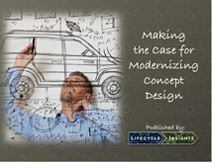Latest News
September 17, 2013
 |
“A good handicraft has a golden foundation” is an old Danish maxim that architects live by, and, it seems, one that designers do too. A study by PTC found that 7 out of 10 respondents say that concept design is a rich source of intellectual property for their company. And, of course, there’s widespread recognition of the fact of life that 70 or more percent of a product’s cost is designed in by the time an idea moves out of concept design into modeling. This raises the question: If concept design is the golden foundation of good handicraft, how come there are so few technologies that empower concept design?
That’s the central question posed by today’s Check it Out eBook, “Making the Case for Modernizing Concept Design,” an 8-page PDF developed and written by industry analyst Chad Jackson of Lifecycle Insights and funded in part by PTC. The answer, Jackson says, is that a pair of enabling technologies for concept design exist already. The trick is combining them into a workable solution.
The first technology is 2D drafting and sketching. You know, that form of design that talking heads told you 3D knocked off a decade ago? The second is 3D direct modeling. But not just 3D direct modeling, but 3D direct modeling that is available with—and interoperable with—parametric feature-based modeling.
You may ask why not use both 2D and 3D parametric tools? That’s exactly what’s not cutting it. See, the problem is that each technology’s strength is also a weakness for concept design. For example, most 2D tools tend to fixate on drafting for engineering drawings rather than concept designs, and you can forget about using a 2D drawing for 3D printed prototypes. 3D parametric CAD, a model of rigidity that makes it difficult to go back and tinker with a component, wants to get a design’s features, fit, and functions finalized. And neither of them produces fungible files ready for the give and take of exploring what-ifs.
So what happens is that you probably use legacy 3D models or cross sections of 2D drawings as the starting point for a new concept design. Once you do your concept work, you then begin your “real” modeling by recreating everything you’ve done already. Not the paradigm of efficiency.
The emerging solution, asserts Jackson, is getting your concept design data from wherever—new 2D sketches, existing 3D models, or legacy designs—and using it immediately to investigate your alternatives and options, including 3D printing. The interoperability available through a design tool that accepts 2D and 3D data, and allows 3D direct modeling and parametric feature-based modeling on the same model fits that bill. And, of course, 3D direct modeling gives you a working environment that makes pulling, tugging, and exploring design alternatives a natural way to go about your business.
With direct modeling linking the strengths and overcoming the weaknesses of your 2D and parametric design toolsets as well as adding its own capabilities, you can move from concept to design to detail in a fluid process while eliminating time-eating, error-rich steps, such as recreating designs. The upshot is that you save time and effort, better use legacy data, have more freedom to develop your concepts, and better leverage the strengths of your 2D, 3D parametric, and 3D direct modeling investments.
Jackson writes a convincing piece, and he’s quite good at assembling his argument, laying it out, and mapping answers to the issues that designers live with every day. And he happens to have a really good insight here that should give you something to chew on. Click the Check it Out link and download “Making the Case for Modernizing Concept Design.”
Thanks, Pal. – Lockwood
Anthony J. Lockwood
Editor at Large, Desktop Engineering
Subscribe to our FREE magazine, FREE email newsletters or both!
Latest News
About the Author
Anthony J. Lockwood is Digital Engineering’s founding editor. He is now retired. Contact him via [email protected].
Follow DE





